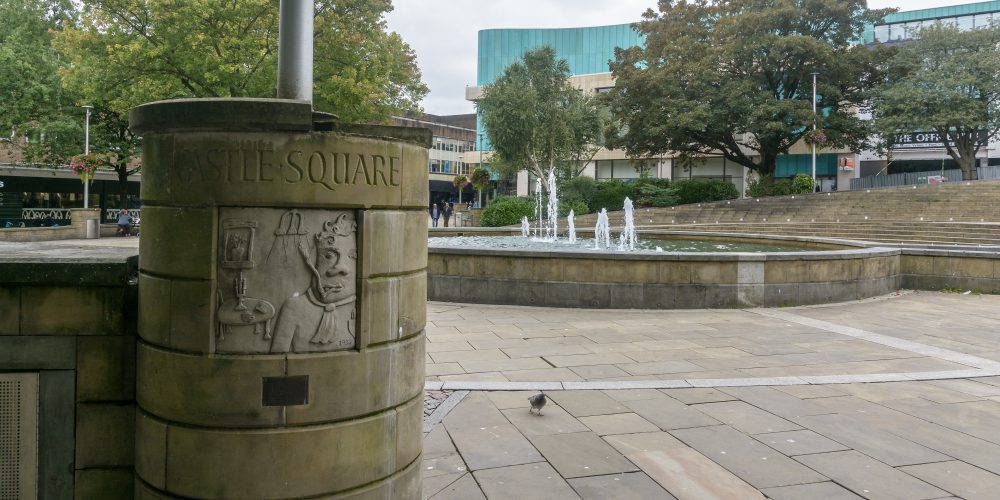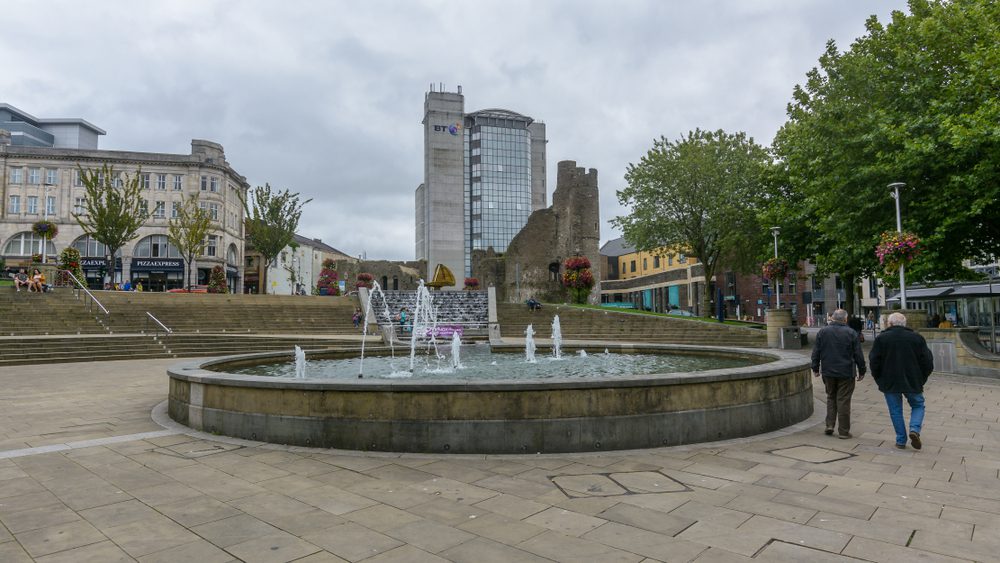
Quick Navigation
Visiting Swansea Castle
The Swansea Castle ruins still stand in the busy city centre of Swansea in Wales. Pivotal in the political upheavals of the medieval era, the castle has withstood sieges, rebellions and the WWII blitz. Only two blocks remain of the once-mighty stronghold that is open to view free to the public.
Parking
Visitors can locate Swansea Castle in the city centre, incongruously nestled in the modern architecture around the site. There are several car parking options nearby, with the closest on-road parking located on The Strand.
Price
The Swansea Castle is open to external viewing at no charge to the public.
Opening
Visitors may view the castle ruins during reasonable daylight hours.
Location & Access
Swansea
SA1 1DW
UK
51°37'13.2"N 3°56'28.7"W
Swansea Castle stands just off the castle square in the centre of Swansea city centre. The castle is incongruously placed and somewhat overshadowed by the imposing BT building and is somewhat lost in the city sprawl. Visitors are welcome to explore the castle from its exterior, as access to the castle's interior is fenced.
Know Before You Go
- Visitors may not access the interior of the castle unless under explicit permission from Cadw.
- Cadw does not permit the use of drones in heritage site areas.
History of Swansea Castle (Time Line)
The site of Swansea Castle offered strategic protection from its defensive knoll that invited fortification since the 1100s. Since Henry de Beaumont — the first Norman Lord of Gower — occupied the site, the castle was the scene of 200 years of battles between the Marcher Lords and Welsh princes.
-1106
William the Conqueror granted Henry de Beaumont the Lordship of Gower in 1106 to establish Norman control in South-west Wales. He constructed the first castle of timber and earthwork, which historical records show was destroyed by the Welsh attack as early as 1116.
-1136-1189
After Henry de Beaumont died in 1119, the Lordship of Gower passed to three of his descendants. However, following the death of King Henry I in 1189, a major Welsh uprising rebellion took place. The fierce fighting between Loughor and Swansea claimed some 500 Anglo-Norman lives, although no evidence suggests the Welsh attacked them at this time.
-1192 (Siege)
After King Richard came to power, much of the truce created by his father fell away under Richard's rule. In 1192, Lord Rhys, the Prince of Deheubarth, laid siege to the Swansea Castle for over ten weeks, attempting to starve the castle occupants. The castle, however, withstood this siege as well as another earlier attack in 1189.
-1203
King John I granted his favourite, William de Braose, the lordship of Gower; however, his favour was fickle, and de Braose fled to France, where he died in 1211. His wife and son were not as fortunate and were imprisoned in Windsor Castle and starved to death. The de Braose family sought allegiance with the powerful Wesh lord Llywelyn ap Lorwerth and entered into war with the crown.
-1212 (Rebellion)
Rhys Grug, the son of Rhys in allegiance with, sacked and burned Swansea while the castle was still under the command of King John. The castle briefly returned to the de Braose hands, but Rhys Grug again attempted to rid the English from the area and attacked Gower. After King John's death, the de Braose clan entered into reconciliation with King Henry III and once again allied themselves with the crown.
-1220
John de Broase once again assumed control of Gower and rebuilt much of the timber and earthwork castle in stone. On his death in 1232, the lordship passed to William de Braose II, under royal guardianship, until he reached majority in 1241.
-1276-1283
The two Wars of Welsh independence substantially altered the political landscape of Wales. The definitive conquest of the Welsh by Edward I reduced the threat of the uprisings and rebellions that plagued the land for centuries. With lessened military necessity, William de Braose set about making the castle fit for a lordly residence.
-1280s
William de Brosae started work on the "new castle", much of the ruins we see today. He set about to build a suite of rooms for residence and a great hall for entertaining and a private family area called a solar tower with cellars constructed below it.
-1287
The Welsh again launched an attack on Gower and captured Oystermouth Castle nearby. William Cragh, one of the Welsh soldiers delightfully named William the Scabby, was caught in Swansea Castle and sentenced to hang. He offered compensation to William de Braose II, who refused and sealed the poor man's fate.
His first hanging was cut short by a fallen beam, and they hanged him again until sunset. According to historical documents, when his family recovered the body, he miraculously returned to life, living another 18 years.
-1291
William de Brasoe III became Lord of Gower and set about making the castle fit for a lord. He added a garderobe and window seats and additions to the castle in keeping with modern styles of architecture.
-1320
Williams' only son passed away, and he made his eldest daughter Alina and her husband John de Mowbray his heirs to his estate and Lordship of Gower. King Edward attempted to seize the castle and grant the state to his ally, Hugh Despenser, causing the Barons to revolt against the crown.
-1322
Mobray seized Gower but was captured in battle and sentenced to death by hanging at the orders of the King. Alina and her son, John, suffered imprisonment in the notorious Tower of London until Edward I died in 1331.
-1331
John de Mowbray became Lord of Gower and embellished the castle with an arcaded parapet walk that still stands today. Moving into a social circle, the de Mowbray's did not spend much time in the castle and prefered their English estates. Stewards mostly ran their affairs in the castle, adding another building in the castle bailey called Place House.
-1402
After several years of peace, Owain Glyndŵr supporters claimed him Prince of Wales. In the corresponding rebellion, Owain's forces had attacked most of the English occupied castles. Sir Hugh Waterton commenced repairs on Swansea Castle in preparation for a potential attack.
Yeoman archers and military forces were garrisoned at Swansea Castle and spies to forewarn of a potential attack by Owain. Historical records are unclear as to whether the Welsh rebels attacked Swansea Castle or not.
-1455-1487
Lord Herbert Raglan, the Lord of Gower, ordered gunports to be added to the castle during the tumultuous War of the Roses. His successors included Earls of Worcester, Marquis of Worcester and Dukes of Beaufort, who ruled the territory in absentia until the 20th Century.
-1647
Oliver Cromwell was granted the Lordship of Gower, but the castle at this time was mostly abandoned. By 1650, historical records refer to the castle as ruined.
-1678-1770s
Artwork of the period depicts the castle as a glass blowing factory, and excavations support this theory. In 1700, the townspeople built a town hall in the castle courtyard, and in 1750, the once Great Hall became a poorhouse or workhouse. By the 1770s, the grand old courtyard was a market, and soon other buildings filled Castle Lane. Some Georgian residences sprung up on the site of the castle.
-Early 19th Century
As the industrial revolution took hold, a post office replaced the town hall, and industrial buildings sprung up in the ditch between the old and new castle. Growing commerce prompted the industrialists to convert the curve of the old river and dig out a new depth to make a more direct route to the sea.
Although the dock was filled in the 1930s, it still bears the name The Strand, referring to the river that flowed at the base of the castle walls.
-The Mid-1800s
The square tower of the castle was a debtors prison, where the unfortunate occupants had to provide their furnishings and income, sometimes with their whole family.
-The 1930s
Celebrated poet Dylan Thomas worked at the South Wales Daily Post situated in the castle courtyard.
-The Mid-1900s
Swansea was the site of intensive bombings during WWII, which destroyed the daily post buildings that occupied the castle courtyard. The council only removed the debris in 1976, where the future of the castle was still uncertain.
-1952-Today
The castle received a grade I heritage listing in 1952 and is now a Scheduled Ancient Monument. In early 2010, a collaborative project funded by European Regional Development Fund and Welsh Government opened the castle to the public. They also added a chrome paved courtyard and information panels.
Swansea Castle Occupants
- 1106: Henry de Beaumont is the builder and first occupant of Swansea Castle, a typical timber and earth fortification period.
- 1136-1189: The de Beaumont family occupies the castle.
- 1203: William de Braose is granted the Lordship of Gower and occupies the castle but is shortly dispossessed of the estate.
- 1215: The castle is briefly restored to the Broase clan.
- 1220: The de Braose family once again assumes lordship of the castle and Gower with John de Broase.
- 1224: William de Braose II assumes lordship and occupies the Swansea Castle, and conducts extensive repairs.
- 1291: William de Braose III assumes occupancy and improves the castle lavishly.
- 1320: William's eldest daughter Alina and her husband John de Mowbray take occupancy of Swansea Castle.
- 1331: John de Mowbray, son of Alina, takes occupancy of the castle, but the castle loses favour as a primary residence.
Images of Swansea Castle





Images Supplied and licensed from Shutterstock Standard Licence Package
Swansea Castle Q&A
What Remains of Swansea Castle?
The Swansea Castle remains are that of the 13th and 14th-century build. One may view the outer walls of the great hall, a communication tower and a four-sided Solar tower. On the north-eastern side, one may also find a garderobe or latrine tower, and 14th-century arcades remain on the castle's outer walls. Still, visitors may not access the interior, which holds evidence of vaulted rooms and preserved portals.
How Large Was Swansea Castle?
The original castle was a sub-rectangular structure with an oval enclosure standing above the River Tawe to the east and protected on the north, south and west sides by an outer bailey. Historians suggest that a motte stood in the inner bailey, but it may have been a ringwork fortification. The motte or ringwork was around 52 m (170.60 ft) in diameter and second only in size to Cardiff Castle.
Location of Swansea Castle
Although historians refer to the old and new castles, there was no real division between the two structures geographically. The late 13th-century build is scheduled separately to the older part of the castle not covered by these buildings in the south.
The separate scheduling of near adjoining but separately scheduled areas creates the false impression of two different castles. The castle is located on a strategic position commanding the lower river crossing and the main east to west route in South Wales.
Today, visitors may view a small part of the later castle, which at its prime stretched from Welcome Lane in the north to Caer Street in the south. From the cliff-top, the castle extended from the east almost to Princess Way in the west.
